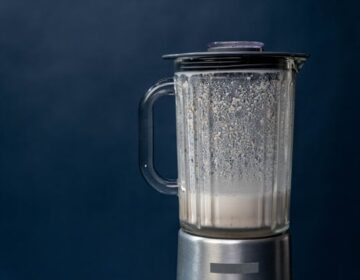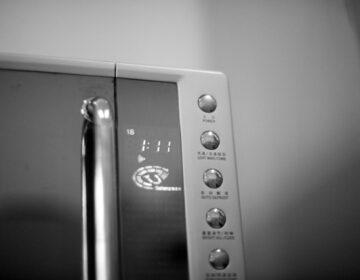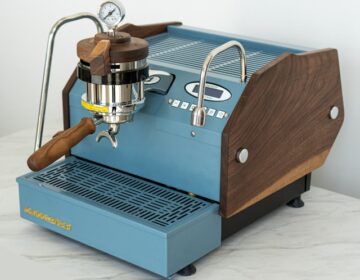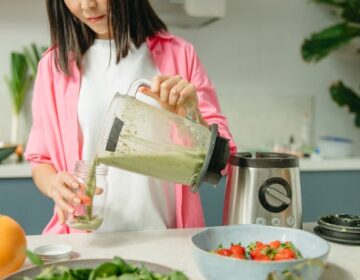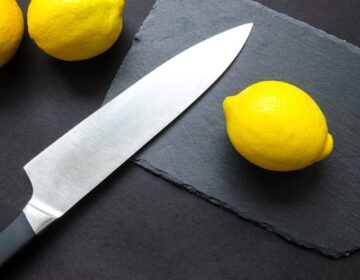Choosing the Best Blender for Smoothies
Choosing the right blender for smoothies can elevate your kitchen game, making it easy to whip up delicious, healthy drinks. This guide explores key features to look for, including power, speed settings, blade quality, and container material. From compact models to high-powered countertop blenders, find out how to select a blender that meets your smoothie needs, ensuring smooth, creamy results every time.
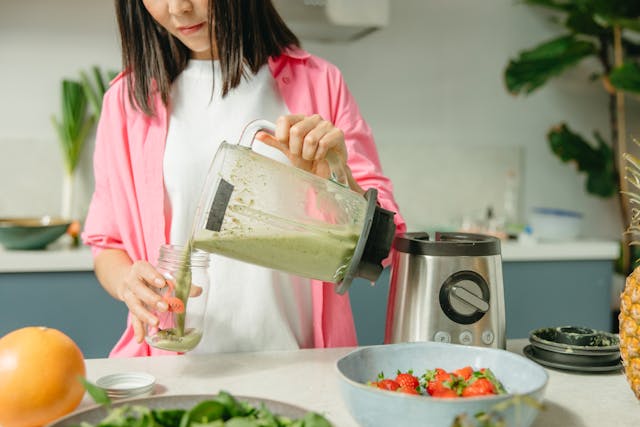
Links on this page are affiliate links. If you make a purchase through one of these links, UtilityCompass.com may earn a small commission at no extra cost to you. UtilityCompass.com does not sell any products; it simply shares recommendations and ideas and is not involved in the purchase process or any post-sale responsibilities.
⭐ Good Deal: https://amzn.to/4hHWp5Q ⭐
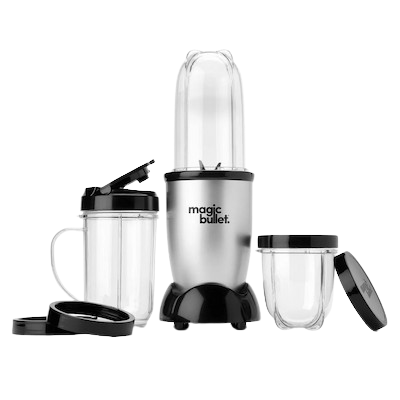
- Types of Blenders for Smoothies
- Key Features to Consider in a Blender
- Essential Features for a Smoothie Blender
- Final Tips for Picking the Right Blender for Smoothies
Finding the perfect blender for smoothies can make a world of difference in your kitchen. With so many models available, it’s crucial to understand the key features that will help you whip up delicious, healthy drinks with ease. This guide breaks down the essential factors to consider, ensuring you select the best blender to suit your smoothie-making needs.
Types of Blenders for Smoothies
If you’re serious about making smoothies, choosing the right type of blender is crucial. Not all blenders are created equal. Some struggle with frozen fruits, leafy greens, and hard ice cubes. To help you decide, we’ve broken down the most popular types of blenders for smoothies. Each option has its pros and cons, depending on your needs, kitchen space, and budget.
Countertop Blenders: The Powerhouse Option
Countertop blenders are the most powerful option for smoothie lovers. They have larger motors, bigger jars, and more features than other blender types. If you want silky-smooth smoothies, this is your best bet.
Why Choose a Countertop Blender?
Powerful Motors: These blenders usually have 700 to 1500 watts of power. This allows them to crush frozen fruits, nuts, and ice.
Larger Capacity: Their containers range from 1.5 to 2 liters. You can make large batches in one go.
Durable Blades: They use stainless steel blades that stay sharp longer and handle tough ingredients with ease.
Versatility: Besides smoothies, you can make soups, nut butters, and sauces.
Drawbacks of Countertop Blenders
Takes Up Space: Countertop blenders are larger and require more storage space.
Higher Price: They tend to cost more than personal or immersion blenders.
Who Should Buy a Countertop Blender for Smoothies?
If you love creamy smoothies or blend large batches for your family, a countertop blender is the way to go. It’s perfect for those who value power, capacity, and versatility in the kitchen.
Personal Blenders: Compact and Portable Choice
If you need a blender for quick, single-serve smoothies, a personal blender is a great option. It’s small, lightweight, and ideal for people on the go.
Why Choose a Personal Blender?
- Portability: Many personal blenders come with to-go cups, so you can blend and drink from the same container.
- Compact Size: Personal blenders are small enough to store in a cabinet or even leave on the countertop.
- Easy to Clean: Since the blending jar doubles as your smoothie cup, there’s less cleanup.
- Affordable Price: Personal blenders are cheaper than countertop models, making them ideal for budget-conscious buyers.
Drawbacks of Personal Blenders
- Limited Power: Most personal blenders have motors between 200 and 500 watts. They may struggle with frozen fruit or large ice cubes.
- Small Capacity: The jars are usually 16 to 24 ounces, suitable for one or two servings.
- Fewer Features: Personal blenders typically have only one or two speed settings.
Who Should Buy a Personal Blender for Smoothies?
If you make smoothies for one person or need a blender you can take to work or the gym, a personal blender is a smart choice. It’s compact, affordable, and easy to use.
⭐
The Magic Bullet Blender is a compact and versatile kitchen tool. With a 250-watt motor, it can chop, blend, whip, and grind. The set includes cups and lids, so you can make and take drinks on the go. Its one-step operation and easy cleaning make meal prep fast and simple. Its small size fits easily in any kitchen. The included recipe guide offers ideas for quick and tasty dishes.
⭐
The Black+Decker PowerCrush Blender has a 700W motor and 4-tip blade for smooth blending and ice crushing. Its 6-cup glass jar makes pouring easy, and 4 speed settings offer precise control. Dishwasher-safe parts make cleanup simple. With a sleek design and strong performance, this blender is great for smoothies, shakes, and more. Customers praise its power and ease of use.
⭐
The nutribullet Personal Blender has a 600-watt motor that quickly blends fruits and vegetables into smooth, nutritious drinks. With a simple push, twist, and blend, it makes healthy eating easy. The 24-ounce cup is dishwasher-safe for fast cleanup. Compact and backed by a warranty, it’s perfect for superfood smoothies and shakes to support an active lifestyle.
Immersion Blenders: Are They Good Enough?
Immersion blenders, also known as hand blenders, are small handheld devices. While they excel at pureeing soups and sauces, they aren’t the best choice for smoothies.
Why Choose an Immersion Blender?
- Compact and Lightweight: It takes up little space and fits in kitchen drawers.
- Multi-Purpose Use: Besides smoothies, you can blend soups, baby food, and sauces directly in a pot.
- Easy to Clean: Most immersion blenders have removable blending wands that are dishwasher-safe.
- Budget-Friendly: Immersion blenders are one of the most affordable options on the market.
Drawbacks of Immersion Blenders
- Limited Power: They struggle with frozen fruits and hard ice cubes.
- Small Blending Area: Since you blend in a cup or pot, you’re limited by the container size.
- Messy Blending: Without a lid, splashing can happen while blending.
Who Should Buy an Immersion Blender for Smoothies?
An immersion blender is best for people who only make soft fruit smoothies or want a multi-purpose kitchen tool. It’s also ideal for those with limited kitchen space.
Blenders vs. Food Processors: Key Differences
At first glance, a blender for smoothies and a food processor may seem similar. But each is designed for different tasks. Here’s how they differ.
How Blenders for Smoothies Differ from Food Processors
- Blending vs. Chopping: Blenders puree, while food processors chop, dice, and shred. Smoothies require a liquid base, but food processors don’t.
- Blade Design: Smoothie blenders have sharp, angled blades designed to crush ice and blend liquids. Food processors use flat, S-shaped blades for chopping.
- Jar Shape: Blender jars are tall and narrow, which creates a vortex for smooth blending. Food processors have wide, shallow bowls.
- Motor Power: Blenders need higher wattage to blend ice and frozen fruit. Food processors don’t need as much power.
When to Use a Blender for Smoothies
- For creamy smoothies made with frozen fruits, leafy greens, and seeds.
- When you want a drinkable, lump-free texture.
- For making large batches of smoothies.
When to Use a Food Processor
- For chopping vegetables, shredding cheese, or kneading dough.
- When you don’t need a liquid base for blending.
- For making thicker pastes, dips, and doughs.
Which Should You Choose for Smoothies?
If your main goal is to make smoothies, stick with a blender. It’s designed to crush ice, blend frozen fruit, and handle liquids. Food processors are better for dry ingredients and thicker mixtures.
Choosing the right type of blender depends on your needs, space, and budget. Countertop blenders are ideal for power and capacity. Personal blenders are perfect for single-serve smoothies on the go. Immersion blenders work for soft ingredients but struggle with frozen fruits. And while food processors have their place in the kitchen, they aren’t great for smoothies.
If you’re looking for the smoothest, creamiest results, go for a countertop blender. For convenience and portability, pick a personal blender. If space is a priority, an immersion blender may work in a pinch. No matter which type you choose, you’ll be on your way to enjoying fresh, homemade smoothies in no time.
Key Features to Consider in a Blender
Choosing a blender for smoothies isn’t just about picking the most expensive option. Key features like power, blades, speed, and container type make a big difference. Each feature affects how smooth, fast, and easy it is to make your favorite blends. Here’s a breakdown of what to look for when buying a smoothie blender.
Blender Power: How Much Do You Need?
Power is one of the most important factors when choosing a blender for smoothies. It determines how well the blender can handle frozen fruits, ice, and leafy greens. The more powerful the motor, the smoother the blend.
Power Ranges Explained
- Low Power (250-500 watts): Suitable for soft fruits like bananas and berries. Struggles with ice or frozen fruits.
- Medium Power (500-1000 watts): Can crush ice and frozen fruits but may need extra time. Ideal for most users.
- High Power (1000+ watts): Handles tough ingredients like nuts, seeds, and frozen fruits with ease. Produces ultra-smooth results.
What Power is Best for Smoothies?
If you want silky-smooth smoothies with frozen fruit and leafy greens, go for at least 700 watts. High-power blenders (1000+ watts) are best if you frequently blend hard ingredients like ice and nuts. For basic smoothies, 500 to 700 watts may be enough.
Why Power Matters
- Blends Faster: A high-wattage blender processes ingredients more quickly.
- Handles Tough Ingredients: More power means better performance with ice, frozen fruit, and hard veggies.
- Longer Lifespan: Powerful motors last longer, even with frequent use.
Blades: Curved, Sharp, or Multi-Blade Design?
The design and quality of the blades directly impact how well your blender breaks down ingredients. Not all blades are created equal, so it’s important to know what to look for.
Types of Blades
- Straight Blades: These blades work well for liquids but may struggle with frozen fruits and ice.
- Curved Blades: Curved blades create a vortex, pulling ingredients toward the center for smooth blending.
- Multi-Blade Designs: Multi-blade setups have different blade angles, improving blending speed and efficiency.
Blade Material
- Stainless Steel: Rust-resistant, sharp, and durable. The best choice for a smoothie blender.
- Plastic or Coated Blades: These dull quickly and may not handle hard ingredients. Avoid these for smoothie blenders.
Which Blade Design is Best for Smoothies?
Curved, multi-blade designs are best for smoothies. They pull ingredients into the vortex, ensuring no chunks remain. Look for stainless steel blades, as they stay sharp and are strong enough to crush ice.
Why Blade Design Matters
- Smooth Consistency: Better blades reduce chunks, giving you creamy, lump-free smoothies.
- Faster Blending: Multi-blade designs blend faster, saving time in the kitchen.
- Long-Lasting Durability: Stainless steel blades resist wear and tear, even with regular use.
Speed Settings: How Many Do You Really Need?
Speed settings allow you to control how quickly and thoroughly your blender processes ingredients. While some blenders have multiple speed options, others rely on a simple high/low switch.
Common Speed Options
- Single-Speed Blenders: Simple, one-speed operation. Press a button, and it blends.
- 2-3 Speed Blenders: Offer basic control, with high, low, and pulse options.
- Multi-Speed Blenders (5+ speeds): These give you more precision, letting you blend soft fruits slowly or crush ice quickly.
The Role of the Pulse Button
A pulse button offers short bursts of power. This is useful for breaking down tough ingredients without over-blending softer ones. It’s also handy for clearing air pockets in the jar.
How Many Speeds Do You Need for Smoothies?
A blender with 2 to 3 speed settings is sufficient for most users. The pulse button is a must-have, especially for dealing with frozen fruits and nuts. Multi-speed blenders (5+ speeds) are ideal for those who want more control.
Why Speed Settings Matter
- Custom Blending: Adjust speed for soft fruits, hard ice, or leafy greens.
- Efficient Processing: Start slow, then increase speed to avoid splashing.
- Avoid Over-Blending: Pulse mode helps control blending, so you don’t end up with juice instead of a smoothie.
Container Type for Smoothies: Glass, Plastic, or Metal Jars?
The container, also called the blending jar, affects durability, visibility, and ease of use. Each material has its pros and cons.
Container Materials
- Plastic Jars: Lightweight and shatterproof but prone to scratches and stains. Look for BPA-free plastic.
- Glass Jars: Heavy, sturdy, and scratch-resistant. They don’t absorb odors or stains, but they can shatter.
- Metal Jars: Durable and stylish but opaque, so you can’t see the blending process.
Capacity Matters Too
Container size ranges from 16 ounces (personal blenders) to 72 ounces (countertop blenders). Larger containers are better for families or those who make big batches.
Which Container is Best for Smoothies?
For large-capacity blenders, glass is a great choice if you want to avoid stains and odors. For personal blenders, BPA-free plastic is lightweight and durable. Avoid metal if you like to watch your smoothie blend.
Why Container Type Matters
- Durability: Plastic jars are shatterproof, while glass jars resist scratches and stains.
- Portability: Plastic jars are lighter and better for personal, on-the-go blenders.
- Blending Visibility: Clear glass or plastic lets you see the blending process.
Picking the best blender for smoothies means focusing on four key features: power, blades, speed, and container type. Each of these elements plays a critical role in how smooth, fast, and easy your blending experience will be.
- For Power: Choose a blender with at least 700 watts for frozen fruits, leafy greens, and tough ingredients.
- For Blades: Go for curved, multi-blade designs made of stainless steel for better blending.
- For Speed: Look for 2-3 speeds with a pulse option for more control.
- For Containers: Glass is stain-resistant, but BPA-free plastic is lighter and more portable.
If you want the smoothest, most consistent results, invest in a blender with these essential features. This way, you’ll enjoy creamy, delicious smoothies every time.
Essential Features for a Smoothie Blender
When it comes to picking the best blender for smoothies, certain features can make your experience easier and more enjoyable. Self-cleaning options, quiet operation, dishwasher-safe parts, and portability aren’t just “nice-to-have” — they can save you time, effort, and frustration. Here, we’ll cover the essential features every smoothie blender should have to keep your blending experience smooth and hassle-free.
Self-Cleaning Blender for Smoothies: A Must-Have Feature
Cleaning a blender can be a hassle, especially if ingredients get stuck under the blades. Self-cleaning blenders solve this problem with a simple process. You add water and a drop of dish soap, press a button, and the blender cleans itself.
How Self-Cleaning Works
- Add warm water and a drop of dish soap to the blender jar.
- Press the self-cleaning button or use the pulse setting for 30-60 seconds.
- Rinse the container, and you’re done!
Benefits of Self-Cleaning Blenders for Smoothies
- Time-Saving: No need to disassemble the blades or jar for cleaning.
- Hands-Free Cleaning: The blender does all the work for you.
- Prevents Buildup: Removes food particles that get trapped under the blades.
What to Look For
- Self-Cleaning Button: Some blenders have a dedicated button for this function.
- Wide-Base Jars: Jars with fewer crevices are easier to clean.
- Non-Stick Surfaces: Smooth, non-stick interiors prevent residue buildup.
If you hate washing dishes, a self-cleaning blender is a game-changer. It’s fast, simple, and keeps your blender fresh after every use.
Quiet Blender for Smoothies: Best Models for Morning Use
Blenders are known for being loud, especially when crushing ice and frozen fruit. But modern quiet blenders solve this issue, making it possible to prepare smoothies early in the morning without waking the entire house.
Why Some Blenders Are So Loud
- High-Speed Motors: The more powerful the motor, the louder the noise.
- Blade Vibration: Blades hitting ice or frozen fruit cause loud impacts.
- Container Shape: Wide jars create more noise than narrow jars.
How Quiet Blenders Reduce Noise
- Soundproof Housing: Some models come with a sound shield or cover.
- Rubber Dampers: Rubber feet reduce vibration and prevent noise transfer to countertops.
- Low-Vibration Motors: Motors with advanced tech reduce sound and vibration.
What to Look For in a Quiet Blender for Smoothies
- Decibel Rating: Choose a blender with a decibel rating below 85 dB for quiet operation.
- Sound Shield: Look for blenders with an external shield to block sound.
- Anti-Vibration Base: Rubber bases reduce noise and stabilize the blender.
Quiet blenders are ideal for morning smoothie drinkers or anyone living in a shared space. With a soundproof blender, you can make your favorite smoothie without waking family or roommates.
Dishwasher-Safe Blender for Smoothies: Easy Cleaning Tips
If you want cleaning to be as effortless as possible, look for a dishwasher-safe blender. This feature allows you to place the blender jar, lid, and blades directly in the dishwasher.
What Parts Should Be Dishwasher-Safe?
- Blender Jar: Should be safe for both top and bottom racks.
- Blade Assembly: Removable blades that are dishwasher-safe make cleaning easy.
- Lid and Tamper: Dishwasher-safe lids ensure every part of the blender stays clean.
How to Use a Dishwasher-Safe Blender
- After blending, empty the jar and rinse it quickly with water.
- Place the jar, lid, and blades on the top rack of your dishwasher.
- Run a standard cycle, then let it air-dry.
Benefits of Dishwasher-Safe Blenders
- Hassle-Free Cleaning: No scrubbing or disassembling parts required.
- Time-Saving: Save time by tossing the jar and parts in the dishwasher.
- Hygienic: The dishwasher’s high heat kills bacteria and removes residue.
What to Look For
- Heat-Resistant Jars: Ensure the jar can handle high dishwasher temperatures.
- Removable Blades: Blades should be removable to prevent buildup of food debris.
- BPA-Free Plastic: If you’re using a plastic jar, make sure it’s BPA-free.
Dishwasher-safe blenders are ideal for busy users who don’t want to spend time scrubbing by hand. If you want effortless cleanup, this is a must-have feature.
Portable Blenders for Smoothies: Should You Buy One?
If you’re always on the go, a portable blender for smoothies might be exactly what you need. These small, battery-powered blenders let you blend directly into a cup, so you can take it with you.
What Makes a Blender Portable?
- Compact Size: Portable blenders are smaller, often holding 12-16 ounces.
- Rechargeable Battery: Most use USB charging for portability.
- Travel-Friendly Lid: The blending jar doubles as a travel cup with a leak-proof lid.
When Should You Buy a Portable Blender?
- For Travel: Perfect for hotels, road trips, and vacations.
- For Work or Gym: Blend fresh smoothies right at your desk or locker.
- For Small Spaces: Ideal for people with limited kitchen space.
What to Look For in a Portable Blender for Smoothies
- Battery Life: Choose a model with long-lasting battery life (10-20 blends per charge).
- Blade Power: Look for at least 250 watts to crush frozen fruit and ice.
- Cup Size: Most portable blenders hold 12-16 ounces, which is ideal for one serving.
Benefits of a Portable Blender for Smoothies
- Blend Anywhere: Blend smoothies on the go, at work, or while traveling.
- Lightweight Design: Easy to carry in backpacks or gym bags.
- Easy Cleaning: Blend, drink, and clean in the same cup.
Portable blenders are perfect for busy people who want fresh smoothies on the go. If you’re looking for convenience, flexibility, and easy storage, a portable blender is a smart choice.
When buying a blender for smoothies, consider features that make blending faster, quieter, and easier to clean. Self-cleaning blenders save time by scrubbing themselves. Quiet blenders let you prepare morning smoothies without disturbing others. Dishwasher-safe blenders offer hassle-free cleanup. And portable blenders let you take your smoothie game on the road.
Here’s a quick summary of what to look for:
- Self-Cleaning: Add water, press a button, and let the blender clean itself.
- Quiet Operation: Soundproof blenders are perfect for early mornings and shared living spaces.
- Dishwasher-Safe: Clean blender jars, blades, and lids without manual scrubbing.
- Portable Design: Take your smoothie blender to work, the gym, or on vacation.
By focusing on these essential features, you’ll not only enjoy silky-smooth blends but also reduce the time, effort, and noise involved in making them.
Final Tips for Picking the Right Blender for Smoothies
Choosing the perfect blender for smoothies can be overwhelming with so many options available. From budget to user reviews, warranties, and in-store testing, there are several factors to consider. These final tips will help you make a smart decision and avoid buyer’s remorse. Follow these steps to get a blender that fits your needs, lifestyle, and budget.
Set a Budget for Your Smoothie Blender: How Much to Spend
The price of a blender for smoothies can range from $30 to over $500. Knowing your budget before you shop can prevent overspending or buying a model that doesn’t meet your needs.
How Much Should You Spend?
- Budget Blenders ($30 – $100): Ideal for light use, such as blending soft fruits and small servings.
- Mid-Range Blenders ($100 – $250): Great for daily smoothie lovers. These handle frozen fruits, ice, and leafy greens.
- High-End Blenders ($250 – $500+): Professional-grade models with powerful motors, larger jars, and advanced features.
What Does Price Affect?
- Power: Higher-priced blenders often have stronger motors, leading to smoother blends.
- Durability: Premium blenders last longer and handle daily use with ease.
- Features: High-end models have extras like self-cleaning, soundproofing, and multiple speed settings.
Pro Tips for Setting Your Budget
- If you make smoothies daily, aim for the mid-range or high-end options.
- Occasional users can get by with a budget-friendly blender.
- Consider long-term value, as cheaper blenders may need frequent replacements.
Setting a budget early on will help you focus on blenders that meet your financial limits while still offering key features.
Warranty and Support for Smoothie Blenders: Why It Matters
A good warranty can save you money on repairs and replacements. Since blenders face daily wear and tear, it’s essential to have solid warranty coverage.
What to Look for in a Warranty
- Length of Coverage: Warranties range from 1 year to 10 years.
- Parts Included: Some warranties cover only the motor, while others cover blades and jars.
- Easy Claim Process: Check if claims are easy to submit online or require extra paperwork.
What Types of Warranties Exist?
- Limited Warranty: Covers specific parts, usually the motor, but not the jar or blades.
- Full Warranty: Covers all parts, including blades, jars, and motors.
How to Check Warranty Details
- Visit the manufacturer’s website for warranty details before buying.
- Look for reviews from customers who filed warranty claims.
- Check if the warranty requires you to register the blender after purchase.
Pro Tips on Warranties
- Blenders with longer warranties are typically better built.
- Avoid blenders with only 1-year warranties, especially if you plan to use them daily.
- Look for brands known for excellent customer service and support.
A warranty offers peace of mind, especially when buying higher-end blenders. It ensures you’re protected against manufacturing defects and performance issues.
Finding the right blender for smoothies isn’t just about power and speed. It’s also about budget, warranty, reviews, and in-store testing. Following these final tips will help you avoid buyer’s remorse and pick a blender you’ll love using every day.
Here’s a Quick Recap of the Key Tips:
- Set a Budget: Choose a blender that fits your price range and smoothie needs.
- Read Reviews: Learn from real users and avoid products with common flaws.
- Check the Warranty: Look for at least 2 years of coverage, especially for frequent use.
- Test It In-Store: Check power, noise, and ease of use before buying.
By following these steps, you’ll be sure to pick a blender for smoothies that’s powerful, quiet, durable, and easy to use. Whether you’re a daily smoothie drinker or an occasional health kick enthusiast, the right blender will make your life easier — and your smoothies smoother.
